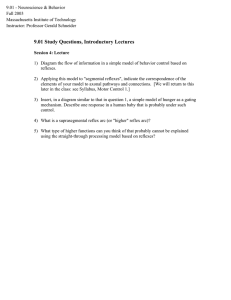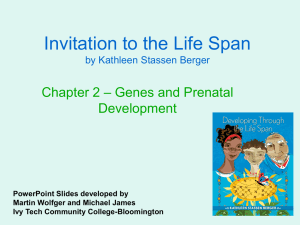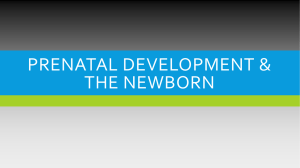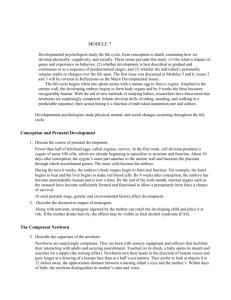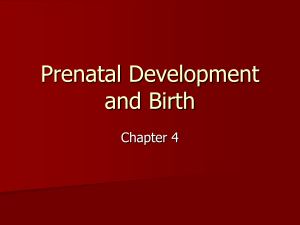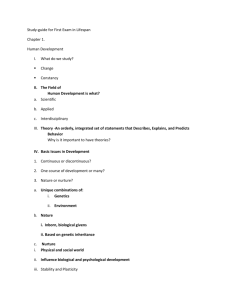The Developing Person Through the Life Span 8e
advertisement
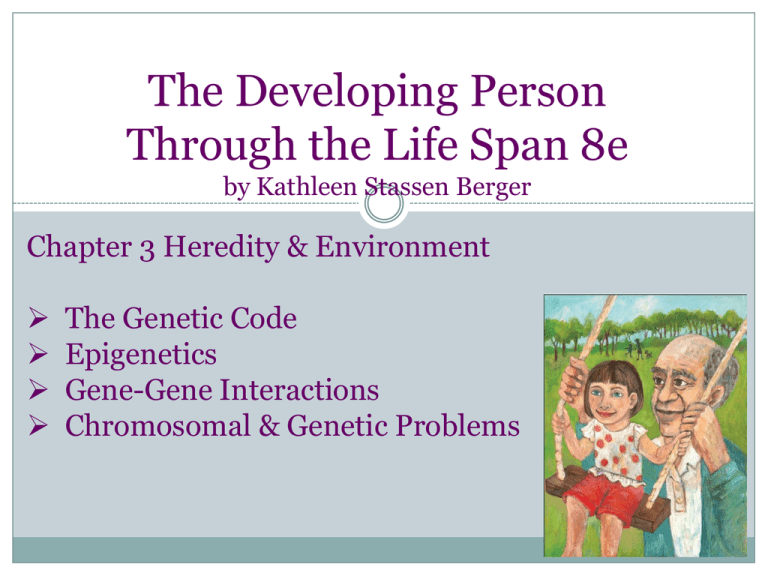
The Developing Person Through the Life Span 8e by Kathleen Stassen Berger Chapter 3 Heredity & Environment The Genetic Code Epigenetics Gene-Gene Interactions Chromosomal & Genetic Problems The Genetic Code Gene Small section of a chromosome, the basic unit for transmission of heredity. Consists of a string of chemicals that provide instructions for the cell to manufacture certain proteins The Genetic Code Chromosomes: Molecules of DNA DNA consists of 46 chromosomes arranged in 23 pairs Genome: The full set of genes that are the instructions to make an individual member of a specific species The Beginnings of Life Gametes • • Reproductive cells (sperm and ova) Each consists of 23 chromosomes. Zygote Two gametes (sperm and ovum) combine and produce a new individual with 23 chromosomes from each parent. Genotype vs Phenotype Genes are passed down from generation to generation Genotype • • An organism’s genetic inheritance, or genetic potential Unique for each organism Phenotype Observable characteristics, including appearance, personality, intelligence, and all other traits. The Beginnings of Life The zygote begins duplication and division then differentiation and specialization occur. Cells change from being stem cells, those from which any other specialized type of cell can form, to being only one kind of cell. Twins Monozygotic (identical) twins Originate from one zygote that splits very early in development Same genotype Dizygotic (fraternal) twins Result from fertilization of two separate ova by two separate sperm Incidence is genetic and varies by ethnicity and age The Developing Person Through the Life Span 8e by Kathleen Stassen Berger Chapter 4 – Prenatal Development and Birth Prenatal Growth Three main periods of prenatal development 1. Germinal Period (1st two weeks after conception): rapid cell division and beginning of cell differentiation 2. Embryonic Period (3rd through 8th week): basic forms of all body structures develop 3. Fetal Period (9th week until birth): fetus grows in size and matures in functioning The Germinal Period Zygote begins duplication and division within hours of conception Development of the placenta Organ that surrounds the developing embryo Sustains life via the umbilical chord Implantation (about 10 days after conception) Developing organism burrows into the placenta that lines the uterus The Embryonic Period Embryo 3rd through the 8th week after conception Begins when the primitive streak appears down the middle of the cell mass Primitive streak becomes the neural tube and later the brain and spinal column Eyes, ears, nose, and mouth form Heart begins to pulsate Extremities develop and webbed fingers and toes separate The Fetal Period Fetus 9th week after conception until birth Growth period Heartbeat detectable via stethoscope Cortex is not fully mature at birth Brain at birth is biggest part of baby Age of Viability Age of Viability Age at which a preterm newborn may survive outside the womb with medical care About 22 weeks after conception Brain is able to regulate basic body functions Chances of survival increase with each day after the 22week mark Who is likely to have a preterm birth? Best predictor is a previous preterm delivery Family History Multiple Births (twins or more) Women with uterine or cervical abnormalities Preterm Births Medical Factors Increasing the Likelihood of a Preterm Birth • • • • • • Diabetes High Blood Pressure Clotting Disorders Birth defects in baby Mother overweight/very underweight Short time between pregnancies Preterm Births Lifestyle Factors Increasing the Likelihood of a Preterm Birth • • • • • • Lack of Social Support Late/No Prenatal Care Domestic Violence Smoking During Pregnancy Drinking Alcohol/Drugs Stress Research suggest low socioeconomic status and lower education level are significantly related to preterm births Low Birthweight Low Birthweight (LBW) less than 5 ½ lbs. Very Low birthweight (VLB) less than 3 lbs 5 ounces Extremely Low Birthweight (ELB) less than 2 lbs 3 ounces Consequences of Low Birthweight: • • • • • • Cognitive Difficulties Delayed pre-linguistic and linguistic development Visual and hearing impairments Attention Difficulties Behavioral Difficulties Higher rates of obesity, heart disease, and diabetes Birth Apgar scale Quick assessment of newborn’s heart rate, breathing, muscle tone, color, and reflexes Completed twice (1 minute and 5 minutes after birth) Score of 0, 1, or 2 in each category Desired score: 7 (total) or above Harmful Substances Teratogens Substances and conditions that can impair prenatal development and result in birth defects or even death Behavioral Teratogens Affect the child’s developing brain Developmental disabilities retardation, hyperactivity, and learning Effects do not become evident for months or years Birth Defects from Teratogens Applying the Research Fetal alcohol syndrome (FAS) A cluster of birth defects including abnormal facial characteristics, slow physical growth, and retarded mental development May occur in the child of a woman who drinks alcohol while pregnant Moving and Perceiving The first movements are not skills but reflexes, involuntary responses to a particular stimulus. Brazelton Neonatal Behavioral Assessment Scale (NBAS) A test that measures responsiveness Records 46 behaviors, including 20 reflexes Infant Reflexes Reflexes aid survival breathing, thrashing, sucking, rooting, swallowing, spitting up Reflexes Signal Normal Functioning Babinski reflex When feet are stroked, their toes fan upward. Stepping reflex When held upright with feet touching a flat surface, infants move their legs as if to walk. Swimming reflex When laid horizontally on their stomachs, infants stretch out their arms and legs. Palmar grasping reflex When something touches infants’ palms, they grip it tightly. Moro reflex When someone startles them, infants fling their arms outward and then bring them together on their chests, as if to hold onto something, while crying with wideopen eyes.
